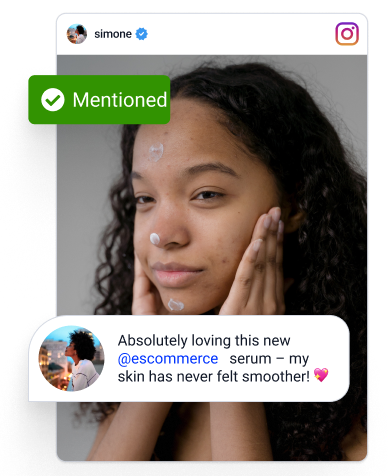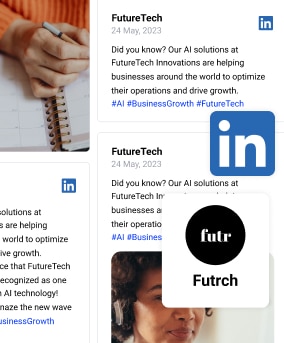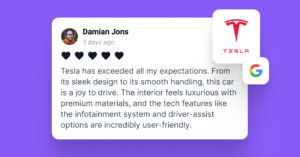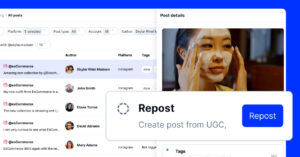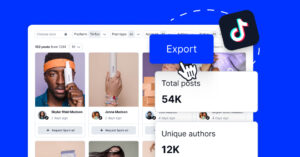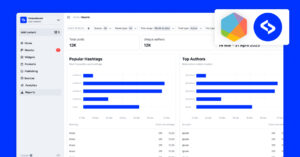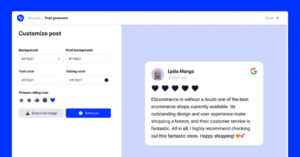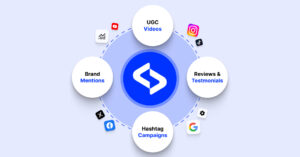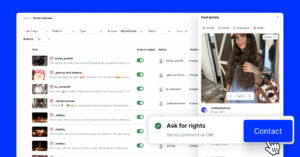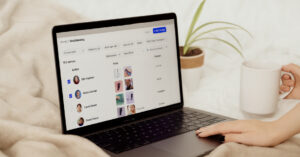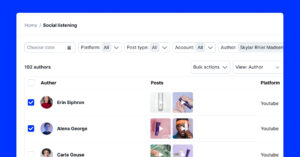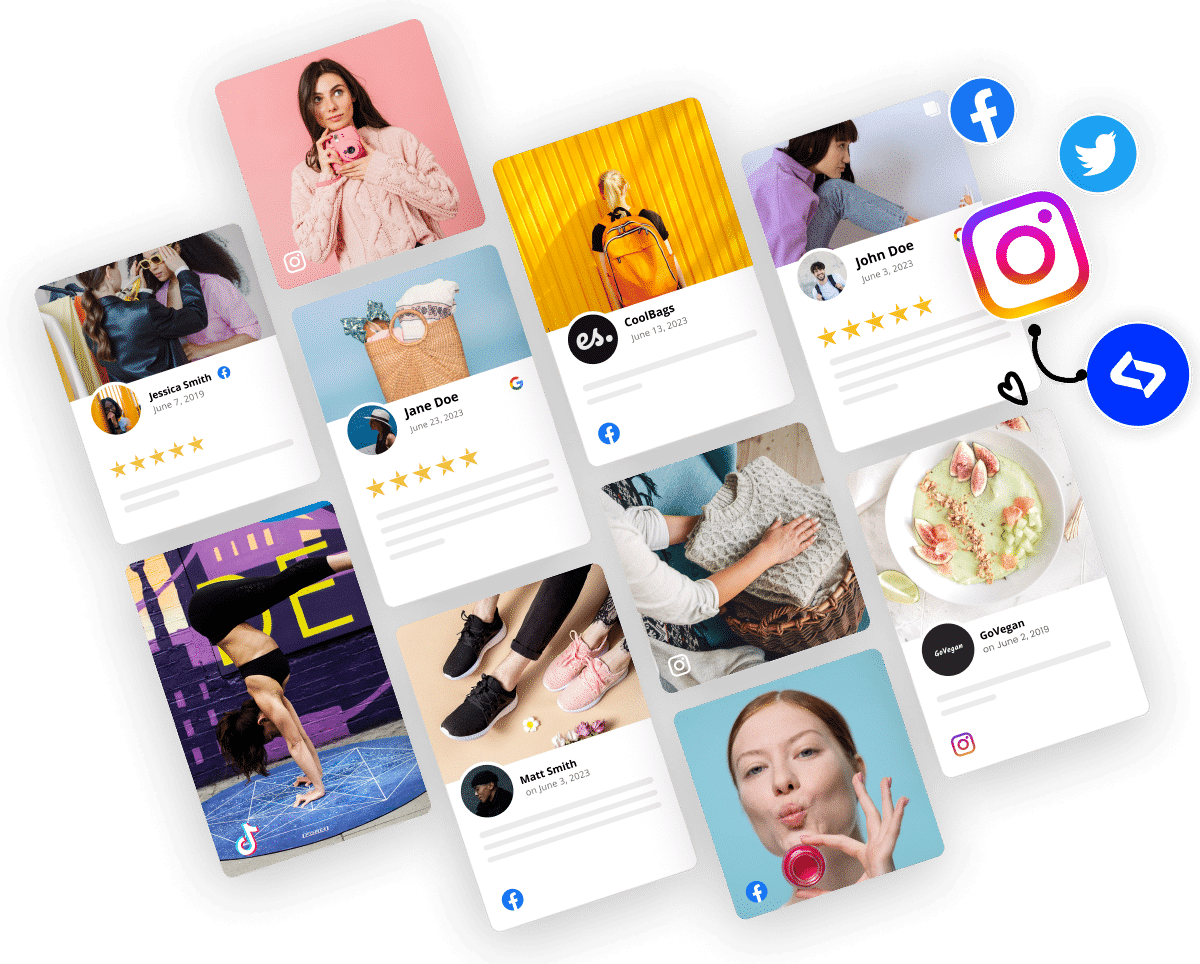LinkedIn is the platform where your audience shares insights, asks questions, and reacts to brands in real time, not just a place for professional networking.
That’s why social listening on LinkedIn is so valuable, as it helps you monitor conversations, understand brand sentiment, and stay ahead of emerging trends.
But here’s the tricky part: LinkedIn monitoring isn’t as straightforward as it is on other platforms. Most tools—and even LinkedIn itself—offer limited access to keywords, hashtags, or broader sentiment tracking, so some third-party tools resort to scraping.
That’s not what EmbedSocial does since we chose to focus on a reliable tool built around your own LinkedIn page, giving you insights that matter.
However, you can always complement that strategy with manual social listening steps via LinkedIn’s native tools, as described below.
Keep reading as I teach you how to set up your own LinkedIn social listening process, what tools can and can’t do, and how to turn engagement into actionable insights.
Let’s explore how to monitor LinkedIn more effectively.
How does your brand benefit from LinkedIn social listening?
Monitoring LinkedIn helps you stay informed, build trust, and make smarter business decisions. Here are the key benefits:
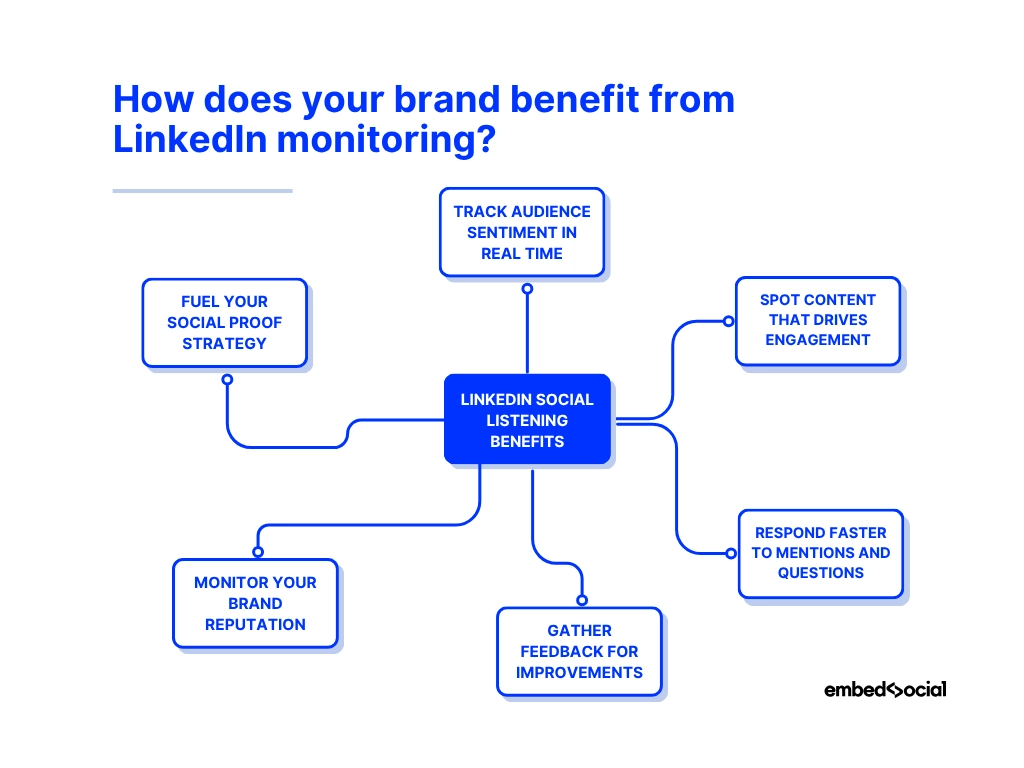
- Track audience sentiment in real time—see how people react to your posts and comments, and understand their tone and feedback;
- Spot content that drives engagement—identify which topics, formats, or messaging spark conversations so you can double down on what works;
- Respond faster to mentions and questions—engage with your audience while conversations are still fresh, building stronger relationships;
- Gather feedback for product and service improvements—use comment insights to uncover suggestions, complaints, or recurring themes;
- Monitor your brand reputation—catch negative sentiment early and manage how your brand is perceived on LinkedIn;
- Fuel your social proof strategy—pull high-performing posts or praise from your audience to embed as social proof on your website.
As you can see, when implemented right, social listening on LinkedIn can reveal important insights that will help you deliver better products and services to your customers. After all, LinkedIn is among the best social media channels for tracking industry trends.
LinkedIn API capabilities and limitations
If you’re thinking of using one of the best LinkedIn tools for monitoring, you should first understand what the LinkedIn API actually allows (and what it doesn’t), so you know that you’ve picked a reliable and legitimate platform that provides precise information.
Here’s what you can currently access via LinkedIn’s API:
You can access content from your own Company Page
LinkedIn’s Community Management API provides access to posts, comments, reactions, and direct @mentions tied to your Page. This includes the ability to get deeper insights via your posts and join social media conversations.
You can’t track hashtags or keywords platform-wide
LinkedIn does not offer any public API endpoints to collect mentions, hashtags, or keywords across the entire network. So tools cannot monitor posts outside of your owned Page content.
You can’t monitor competitor activity
Unless you have admin rights to a competitor’s Page (which you won’t), you cannot legally or technically access their posts, engagement data, or audience interactions via the API.
Group and personal profile data are restricted
LinkedIn does not allow access to Groups, personal DMs, or content shared from personal profiles, which limits your listening scope significantly compared to social media platforms like X or Instagram.
Strict rate limits and compliance rules apply
LinkedIn enforces tight rate limits and only approves apps that meet specific compliance and privacy standards. This makes API-based access slower and more controlled than expected.
Most social listening tools that offer LinkedIn as a platform use API-compliant methods to monitor your own Page or resort to non-official workarounds like browser scraping or manual search, which are unreliable and may violate LinkedIn’s Terms of Use.
That’s why EmbedSocial focuses on what’s permitted: We help you monitor your Page’s activity with full compliance and give you insights that move the needle. Once implemented into your social media strategy, it will get you valuable insights to boost your growth.
What are the native LinkedIn listening tools?
LinkedIn doesn’t offer full-scale social listening like other social media platforms, but it does include a few native tools that help you keep track of your own engagement.
The Mentions tab on your Company Page shows when someone tags your brand using the “@” symbol in a post or a comment. While limited for now, it’s still a useful way to stay on top of direct shoutouts and conversations among your peers.
Inside your Company Page analytics, you’ll find metrics like impressions, clicks, reactions, shares, and comments. It’s not traditional listening, but it helps you measure what content is landing with your target audience, so you know where to improve.
You can also use LinkedIn’s search bar to look up keywords or hashtags and find all the public content that contains them. Note that LinkedIn filters these results.
For a broader view, competitor benchmarking within the analytics dashboard lets you track how your Page stacks up against others in your industry.
And of course, comment notifications keep you looped in whenever someone interacts with your posts—making it easy to respond in real time.
These features give you a glimpse into audience engagement, but they stop at the borders of your own Page. That’s why brands rely on tools like EmbedSocial to consistently monitor LinkedIn activity and turn interactions into insights that drive action.
How to set up a native LinkedIn social listening workflow (manual + light automation)
While LinkedIn doesn’t offer full-fledged social listening tools, you can still build a basic workflow using LinkedIn Search, its native features, and a few third-party workarounds.
Here’s how to set everything up:
Step 1: Define your LinkedIn listening goals
Before jumping into the process, you should decide what to monitor exactly. This helps keep your efforts focused and measurable. You can:
- Track brand mentions (tagged and untagged);
- Identify industry conversations and trends;
- Monitor competitor content and engagement;
- Discover potential leads based on relevant topics;
- Find influencers posting in your niche;
- Understand how people perceive your brand on LinkedIn.
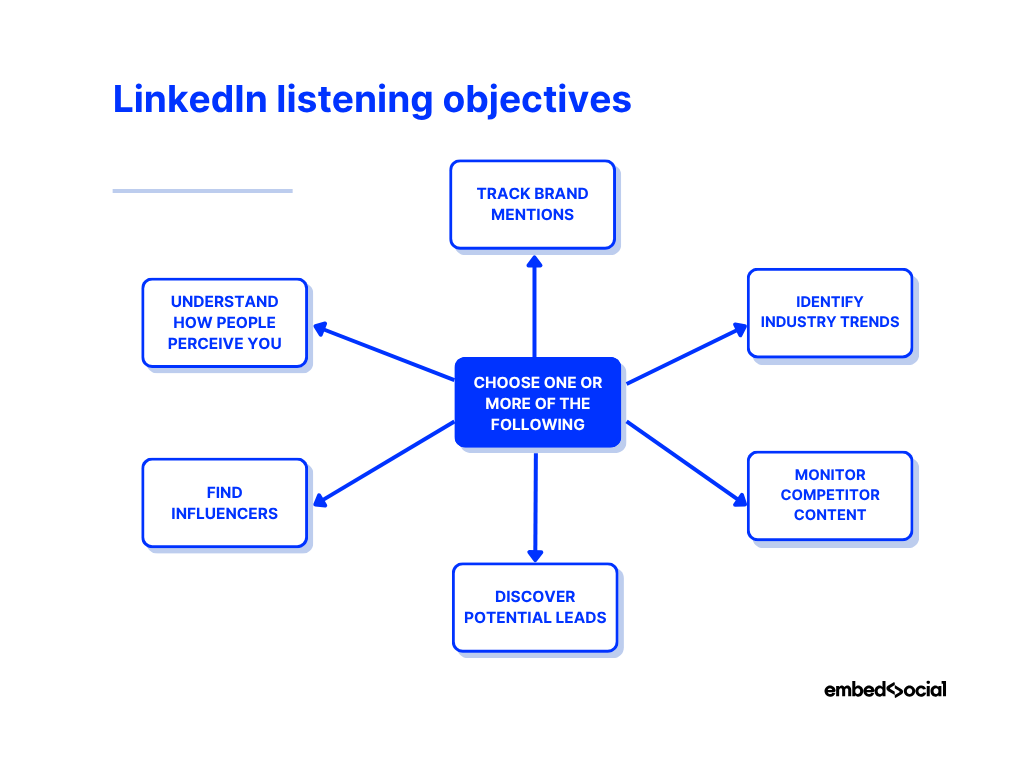
Step 2: Identify relevant keywords, phrases, and entities
Next, you should find the keywords you need to track. These can include some of the following:
- Your brand and product names (e.g. EmbedSocial);
- Common abbreviations or misspellings (e.g. Embed Social);
- Your competitor names (brands in your niche);
- Industry hashtags (e.g. #UGCmarketing, #LinkedInListening);
- Events or campaign titles your audience might mention.
Note: You can also use a free or paid keyword research tool to surface these terms faster.
Step 3: Use LinkedIn’s native search manually
Now comes the main part of your manual workflow. You must use LinkedIn’s built-in search tools to monitor public conversations around your keywords. Here’s how to do it:
- Go to the LinkedIn search bar;
- Enter a keyword in quotes (e.g.
"EmbedSocial"); - Hit Enter, then click Posts in the filters;
- Use the date filter (e.g. ‘Past 24 hours’) for real-time results;
- Scan through posts for relevance, tone, and engagement.
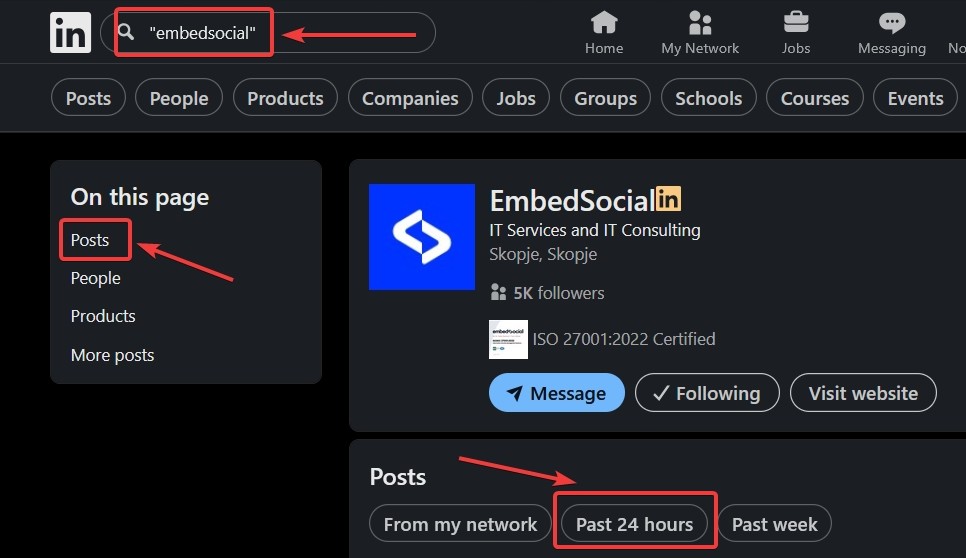
Note: We’re using quotation marks in search so we find the exact target phrases, and thus improve the relevance of our searches.
Step 4: Monitor relevant hashtags manually
You can still track LinkedIn hashtags manually, and it takes a few repeatable steps to do that:
- Search for hashtags like
#UGCmarketingor#SocialListening; - Visit the hashtag page to view recent public posts that include it;
- Filter the results depending on the content type, such as posts, jobs, people, companies, groups, products, services, events, courses, etc.;
- Manually scan and engage with posts that mention your brand or industry;
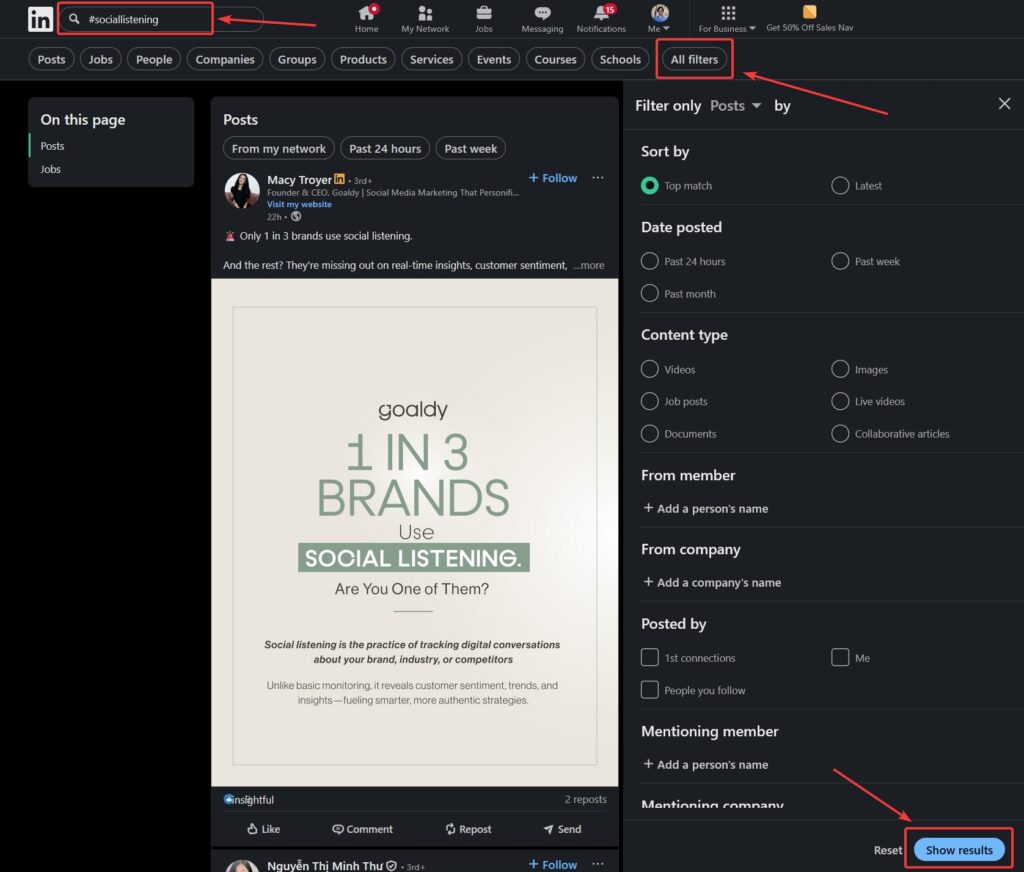
Note: LinkedIn offers very advanced search filters for all its content types, as you can see from the above screenshot.
Step 5: Monitor brand mentions (even untagged)
LinkedIn only notifies you when your Company Page is tagged with “@,” so indirect mentions require a manual process:
- Repeat the search process using variations of your brand name;
- Look out for untagged but contextually relevant mentions;
- Engage with users who discuss your brand, even without tagging it.
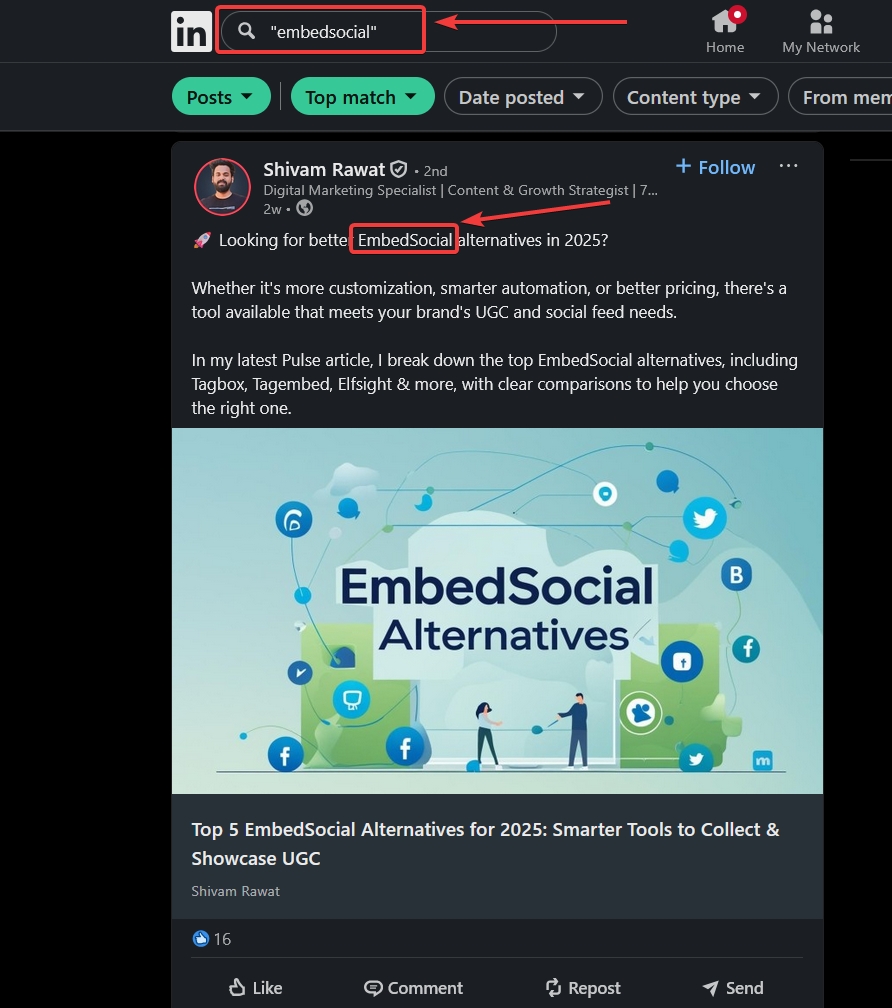
Note: As you can see above, I easily found a brand mention from one of our competitors even though we are not tagged.
Step 6: Set up alerts using third-party tools
Last but not least, you may be able to catch LinkedIn mentions automatically via lightweight external tools.
Two such examples are Google Alerts, which allows you to set alerts using site:linkedin.com "EmbedSocial" for mentions in public posts or articles, and F5Bot, which sends email alerts for keyword mentions, including some LinkedIn and forum content.
Furthermore, you can use a third-party social listening tool that connects to LinkedIn via a direct API connection to get all the data from your official LinkedIn page. Below, I explain one such method using EmbedSocial, our all-in-one social listening and UGC platform.
As you can see, by combining these manual and automated methods, you can build a lightweight LinkedIn social listening process that works—especially when paired with a tool like EmbedSocial for structured Page-level monitoring.
Alternative method: Set up your LinkedIn Page listening
While you can’t access all the social data you would when listening to other social media platforms, you can still do some social listening activities on LinkedIn on a page level.
After all, you can get lots of information from your own LinkedIn page, such as all your posts and your public’s reactions to them, such as comments and likes.
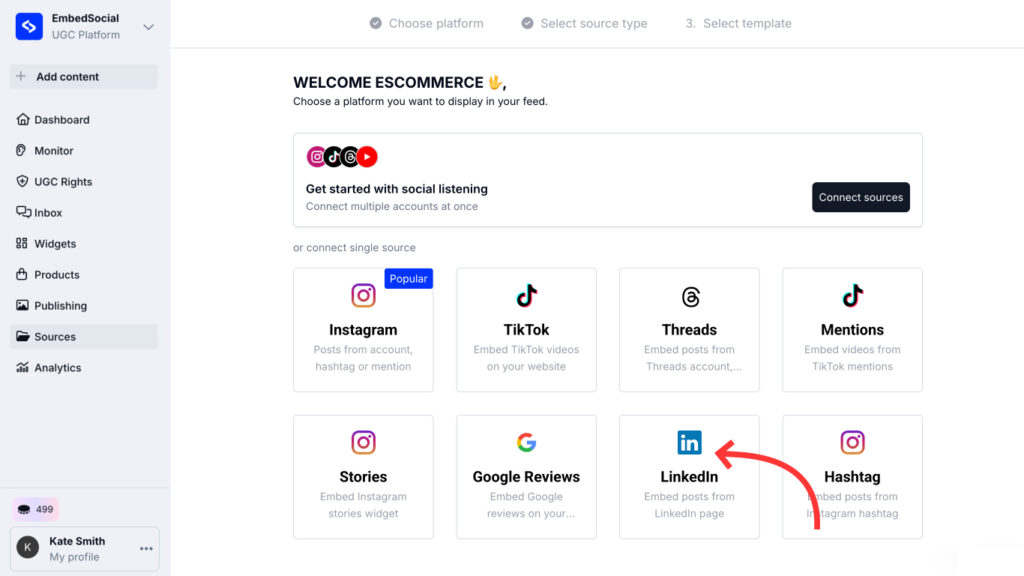
1. Create your LinkedIn account
First of all, you need an EmbedSocial account if you want to monitor your LinkedIn content. The good news is: EmbedSocial offers a 7-day free trial to start with.
2. Connect your LinkedIn Company Page
Head to your EmbedSocial dashboard → ‘Sources’ → ‘Add new source’ and add your LinkedIn page as your main source of user-generated content:
You’ll be prompted to log into your LinkedIn account and authorize access to your Company Page. Once approved, EmbedSocial will sync your posts automatically.
Note: EmbedSocial will begin pulling in your organic posts, along with the reactions attached to each. You’ll be able to view and organize this content in your dashboard.
3. Start monitoring comments on your LinkedIn content
Access the ‘Monitor’ tab from the left ribbon menu to find all the content connected to your LinkedIn Page. You can also use filters to find what you need faster.
You can filter your posts based on date, platform, content type, or specific account. Once you do, you can organize them via tags.
Here you can see the posts that get the most comments and start engaging with the comments from one place.
Note: You can group posts into thematic feeds (e.g., product updates, customer stories, hiring content) or filter by performance. This helps you monitor patterns in audience engagement and identify what content drives the best reactions.
4. Analyze your LinkedIn Page posts
Once you open the ‘Analytics’ tool from the ribbon menu, you’ll be prompted to download your page’s report. You can choose the time range, post type, etc.
Then, tap ‘Upload EmbedSocial data’ and simply select the file you downloaded to get all the information you need to get data such as the hashtags you’ve been using, the content type you’ve been posting, most used keywords, sentiment analysis, and post frequency:
Note: You can easily share your report with all concerned stakeholders—perfect for monthly reporting, executive summaries, or internal audits.
5. Embed your content on your website
With your posts and reactions pulled in, you can now embed your LinkedIn UGC directly on your website using responsive widgets.
You just have to tap ‘Copy code’ in the widget editor and then paste that code in your website builder (and page) of choice to get an engaging widget:
Why use third-party LinkedIn monitoring tools?
While limited, third-party tools still add great value to your LinkedIn strategy, but only within the limits set by LinkedIn’s API. Here’s what you CAN expect:
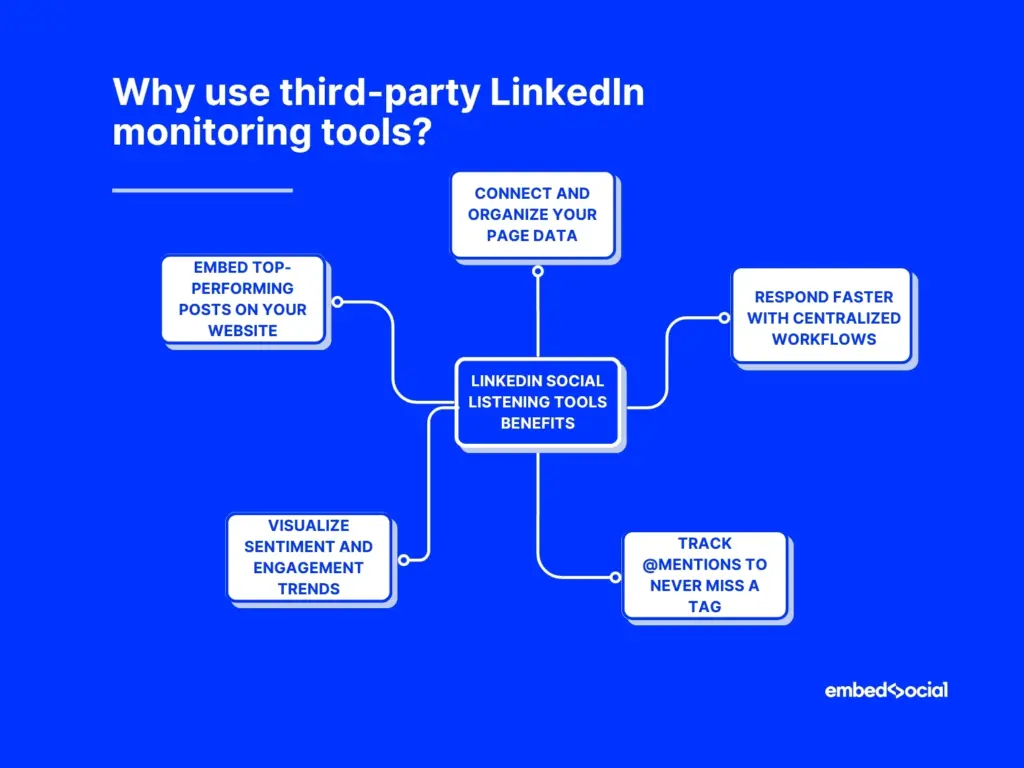
- Connect and organize your Page data – Tools like EmbedSocial let you collect and analyze all your Page’s posts, comments, reactions, and engagement metrics in one place, helping you stay organized and informed;
- Respond faster with centralized workflows—Instead of manually checking posts, third-party tools collect all your new posts with users’ activity on them, so you can manage responses from a single dashboard, which saves you time;
- Track @mentions to never miss a tag – some social media listening platforms are also able to notify you when your Company Page is tagged in a post or comment, thus helping you respond quickly and reinforce your brand awareness;
- Visualize sentiment and engagement trends – EmbedSocial’s dashboards surface key patterns across your LinkedIn content, helping you understand what’s resonating with your target audience and where adjustments are needed;
- Embed top-performing posts on your website – You can easily embed your LinkedIn feed as social proof via visual widgets that auto-sync with your activity.
When all is said and done, third-party social media monitoring tools can’t legally scrape the platform, and if they claim that, they might be using browser scraping or shadow profiles, which often violates LinkedIn’s Terms of Use and can result in revoked access.
That’s why tools like EmbedSocial focus on API-compliant LinkedIn monitoring that gives you access to your own Page, without pretending to offer unavailable features. You get all the reliable social media management that LinkedIn allows you to have.
➡️ Transparency matters, especially when investing in tools to protect and grow your brand.
Monitor LinkedIn the right way: 7 best practices
To build a solid LinkedIn listening workflow, focus on what your Company Page can reveal. These best practices will help you turn engagement into insight:
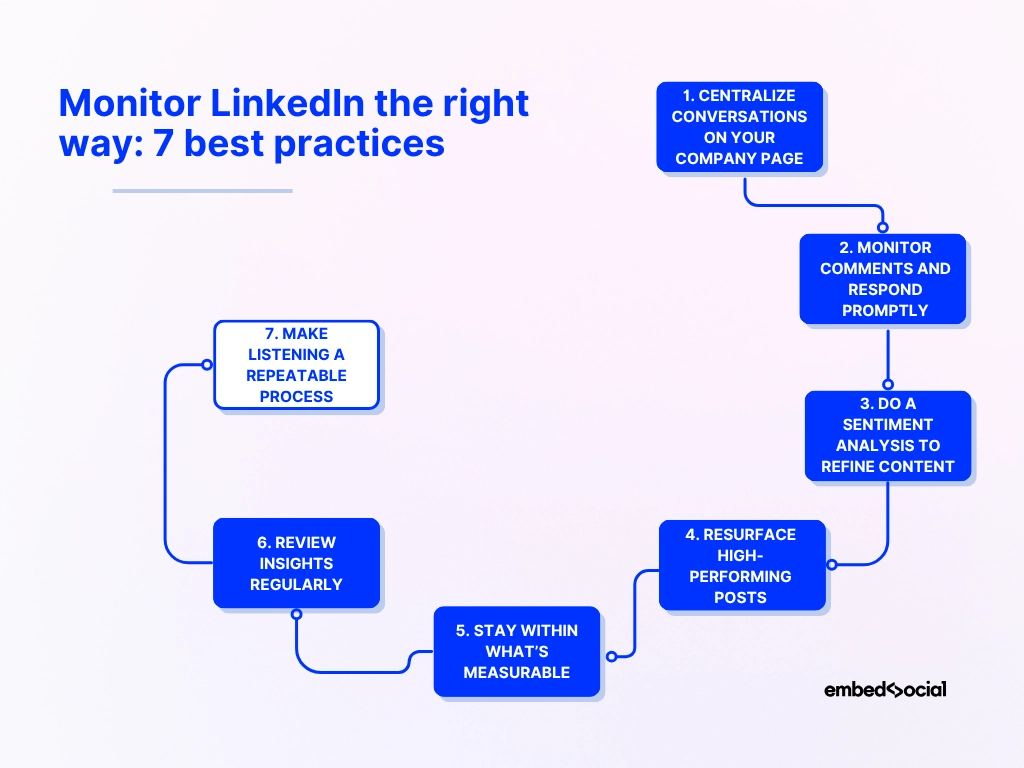
- Centralize conversations on your Company Page—have your team like, share, and comment through the Page so all relevant conversations are easy to track;
- Monitor comments and respond promptly—engaging with your audience in real time builds trust and shows you’re genuinely listening;
- Do a sentiment analysis to refine content—analyze which formats (text, video, image, document) perform best and use comment sentiment to guide messaging;
- Resurface high-performing posts and test content variations—pin top posts or embed them on your site, then experiment with new content types;
- Stay within what’s measurable—LinkedIn tools like EmbedSocial only track your Page, so focus your strategy on what the platform allows;
- Review insights from both LinkedIn and your embedded posts—combine on-platform data with website engagement metrics for a complete picture;
- Make listening a repeatable process, not a one-time task—schedule regular check-ins, build internal workflows, and always rely on your feedback. That’s the best way to build a dependable LinkedIn marketing strategy for your brand.
With the right strategy in place, LinkedIn listening becomes a powerful way to fine-tune your brand’s message and act on what your audience actually cares about.
Conclusion: Turn LinkedIn Page engagement into real insights
You don’t need access to all social media conversations on LinkedIn to do effective social listening, as your Company Page offers plenty of meaningful engagement.
That said, you can still manage any data gaps via LinkedIn’s native tools. However, when all is said and done, once you sign up for a trusted tool like EmbedSocial, you can track post performance, analyze sentiment, respond faster, and leverage customer feedback.
Just remember: social listening on LinkedIn is all about working with what’s permitted, not chasing workarounds that don’t last. So, start by connecting your Page, monitoring what matters, and building a listening system you can rely on.
Ready to start listening where it matters most?
Connect your LinkedIn Page to our social media listening tool to get valuable data and turn every comment, reaction, and mention into a powerful insight.
FAQs about social listening on LinkedIn
Can LinkedIn be monitored?
Yes, but only within certain limits. You can monitor your own LinkedIn Company Page using approved social media monitoring tools like EmbedSocial, but not the entire platform.
How to monitor LinkedIn activity?
Connect your Company Page to a tool like EmbedSocial to track posts, comments, reactions, and mentions—all in one dashboard with sentiment insights.
Is there a free social listening tool for LinkedIn?
Some tools offer free trials, including EmbedSocial. However, due to API limitations, full platform-wide LinkedIn listening is not available, even in paid plans.
Can I track hashtags or keywords across LinkedIn using EmbedSocial?
No. LinkedIn’s API does not allow access to platform-wide hashtags or keyword mentions. EmbedSocial only tracks content from your connected Company Page.
What can I monitor on my LinkedIn Page with EmbedSocial?
You can monitor your own posts and their comments, likes, and reactions. You’ll also get sentiment analysis, performance trends, and embeddable content.
Is it possible to monitor competitor pages on LinkedIn?
No. LinkedIn doesn’t allow competitor monitoring via API. You can only monitor Pages you manage or have admin rights to.
